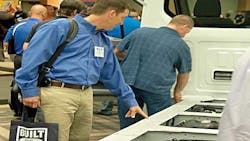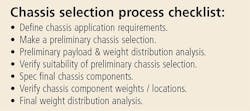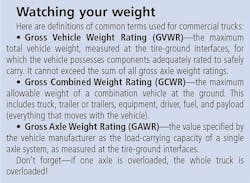THE ultimate goal of a truck equipment upfitter is to provide the customer with a completely satisfying ownership experience, Bob Aquaro told his audience at the “Designing Chassis to Meet Job Requirements” workshop at The Work Truck Show.
The key to this—selecting a chassis that is ideal for what the customer wants it to do—is more difficult than it seems. But some detailed conversations with the customer up front can avoid many of the common causes of disappointing truck performance. A chassis that is too light for the job will be overloaded, resulting in excessive maintenance costs. One that is too large costs more to buy and more to fuel. The wrong wheelbase can result in poor handling. If the wheelbase is wrong, weight can be distributed poorly. The result: overload of one axle, which means the customer can’t use the full GVW rating that he paid for.
Designing a work truck involves a wide range of variables—sometimes conflicting variables. They include overall weight, dimensions (both operational and limits set by government regulations), environmental, regulatory, and financial concerns such as purchase price, taxes, and operating costs.
Talking things through with the customer can avoid such common upfitting issues such as component interference, unplanned modification costs, and preventable delays. Aquaro addressed these problems by looking at the truck specification process step by step, system by system.
• First—establish what the completed truck will be required to do. Where will it operate? How will the truck be driven? How fast and how long on a highway? Off road? How severe are the grades that the truck must climb? What is the customer’s desired life cycle?
Will the application require special equipment? Will the equipment require special mounting? What about power take-offs? If required, what will their operating and duty cycle be?
The answers to these questions will be used to make a preliminary chassis selection. But beyond that, consider:
• Required clear cab to axle length needed to accommodate the selected body
• Second unit payload requirements
• Available frames and chassis components
“What Cab-to-Axle (CA) dimension is required for the truck body the customer wants to use?” Aquaro asked. “Remember to check the usable CA as chassis components can interfere with body installations, rendering the CA less than advertised.”
Other chassis considerations include:
• Required axle ratings and GVW rating.
• Chassis options such as fuel tanks, DEF tanks, and batteries. Their locations can impact the shop if one or more of these components are installed where bodies or equipment is supposed to go.
“Be persistent in checking for component interference issues,” Aquaro said. “Ask and validate. Review body builder drawings of the actual chassis.”
Other considerations include trailer and towing requirements, PTO requirements, and excise tax issues. A truck on which federal excise tax is due represents a 12% price increase.
Analyzing payload and weight distribution
Weight is important—not only the total weight that the truck must carry, but also how it is distributed among the axles. A truck that overloads an axle violates weight laws—even if the truck is below it’s gross vehicle weight rating.
Upfitters should consider doing a preliminary weight distribution analysis to make sure that the truck as envisioned distributes the load properly.
Doing that involves several steps, including identifying the weight and dimensional data of the chassis being considered: its wheelbase and CA dimensions, front axle to back of cab dimension, distance between the cab to body, passenger seating data, and the amount of weight the chassis places on front and rear axles as produced at the factory.
These numbers are plugged into a mathematical formula available from a variety of sources, including NTEA. Aquaro said his company will do the math.
Make sure the truck has a sufficient payload rating to meet the customer’s needs. Simply add up the weights of the chassis and all permanently installed components (such as body and equipment) and subtract the total from the GVW rating of the chassis. The leftover weight is what the truck will be able to carry as payload.
Does the truck have what it takes?
Compare the truck you have in mind against what you have calculated that the truck must have.
Does it have the required GVW rating? Typically, the GVW rating is less than the sum of the gross axle weight ratings (GAWRs), Aquaro said.
The ratings can be limited by the strength of the truck frame, the wheelbase, foundation brakes, engine and / or transmission selection, axle ratio, and payload distribution allowance.
GCWR may be limited by the same factors as the GVWR. Usable trailing weight is usually limited by vehicle payload requirements and the weight on axles—the rear axle only in the case of aft-mounted hitches and all axles if a fifthwheel or gooseneck type hitches are to be used.
Is the frame strong enough?
Frames are rated by their section modulus and by the yield strength of the frame material (usually steel).
The section modulus is a measure of frame strength and rigidity as determined by the shape, material thickness, flange width and depth of the frame expressed in cubic inches.
“Section modulus is not the same throughout the length of the truck frame,” Aquaro said. “Published section modulus is the strongest part of the frame, usually just behind the cab. Other sections may be lower, or on rare occasion higher, than the published area.
Section modulus affects weight because it is affected by the amount of material used. Another factor affecting frame strength—which does not necessarily impact truck weight—is the strength of the material used on the frame. It is measured by its yield strength. Yield strength is the maximum load that can be applied to a material without it being permanently deformed. It is expressed in pounds per square inch (PSI).
“Yield strength is not tensile strength,” Aquaro warned. “Be careful. Most all OEMs publish yield strength. Some publish tensile strength that will be a higher number than yield strength.
Another measure of frame strength is its resistance bending moment (RBM). RBM is the maximum bending moment that a frame can support without permanent deformation. The RBM of a frame is equal to the section modulus multiplied by the material yield strength.
The RBM rating of a frame is useful for comparing frames with different section modulus and yield strength ratings.
Some applications may require the frame to be reinforced. Check with OEM to see if the frame be reinforced at a critical point. For example, a crane mounted at the rear of the truck or one mounted behind the cab.
The proper powertrain
The powertrain engine, transmission, and final drive should be designed to work together to provide the desired performance without being over- or under-sized, Aquaro said.
Critical performance factors include starting and reserve gradeability, geared road speed, and demand road speed.
A variety of factors can impact vehicle performance, such as gross weight, frontal cross section, and the percentage of time that the truck operates at high speeds. All of these affect the aerodynamics of the vehicle.
Also consider the rolling resistance of tires, the efficiency of the driveline, and the road conditions where the truck typically operates. And if the truck has a naturally aspirated engine, altitude will impact performance of the powertrain.
Improving fuel economy
Customers can improve the fuel economy of their trucks by considering E-PTOs, solar power sources, auxiliary power units, idle control systems, auto start-stop, telematics systems, and routing software.
Tires play a big role in fuel economy. Fuel-efficient tires, for example can improve fuel economy by as much as seven percent, Aquaro said.
SmartWay-certified tires improve fuel economy at least three percent 3%, Aquaro said, by lowering rolling resistance. Changes in tire compound and perhaps tread also affect fuel economy.
Using single wide-base tires instead of duals are something else to consider. They offer significant weight reduction as well as low rolling resistance.
“For on-highway applications, reduced truck speed in combination with wide-base singles provides the ultimate combination,” Aquaro said.
Electrical systems
System by system, Aquaro offered suggested things to consider that would enable the completed truck to perform at or above customer expectations.
• Make sure alternators have the capacity to supply the power required by the equipment.
• Minimum battery ratings should be in the 650 to 750 CCA range for gasoline engines and in the 1900 to 2200 CCA range for diesel engines (1400 CCA combined for light-duty diesels).
• Protect batteries from excessive heat, vibration and dirt.
• Think through the ramifications of relocating the battery. Don’t just move them to make it more convenient.
• Consider using LED lights--they reduce maintenance and draw less current. But use caution with LED turn signals. The flasher must accommodate the low current draw of an LED. Otherwise, a rapid flash rate may result.
• Specify a standard sealed wiring harness for all bodies and equipment.
• All ground connections must be made at OEM-provided grounding points.
• Take advantage of OEM offerings such as integrated switches and relay-controlled power routing. Use OEM-provided body builder electrical connections always.
• Use OEM multiplexing and “telematics” provisions as much as possible.
• Offerings and capabilities vary by OEM. Be sure to consider this when evaluating chassis and upfitting bids.
• OEMs provide electrical diagram and schematics for their products. Use them!
Cooling systems
• Upgraded cooling systems (both engine and transmission) are low-cost options that are highly recommended for vocational vehicles.
• Don’t forget that oil is also an engine cooling medium – Supplemental oil coolers and bypass oil filter systems both contribute to engine cooling but they also add weight and service costs.
• Well-designed truck chassis will have well designed cooling systems. Confer with the OEM to determine if supplemental cooling is required and if so, how it should be installed. Be careful, Aquaro warned. You can make things worse instead of better.
Fuel system
• If engine speed control interface is required, be sure that the OEM-provided system is compatible with your equipment.
• In most cases, only truck dealers can set engine speeds with compatible computer systems.
• Never assume that speed control is natural. Check first and be specific!
• Direct substitution alternative fuels such as E-85 and bio-diesel may impact vehicle weight and performance.
• All engine manufacturers have recommended bio-diesel ratings, some as low as B-5! Exceeding the OEM rating may cause emission issues, warranty issues and overall reliability issues. Check first.
• B-100 has 90% of the energy density of conventional diesel fuel.
• E-85 has about 85% of the energy density of gasoline but also has a higher octane rating. Flex-fuel vehicles typically have reduced fuel economy when operating on E-85.
Brake systems
• To the greatest extent possible, try to standardize on components—compressors, dryers, slack adjusters.
• When required, spec factory-relocated components instead of modifying system at a later date. Modifying the system adds cost and certification issues.
• When dealing with air brakes, be sure to consider using air dryers (standard or heated), automatic moisture drains (spitter valves), supplemental remote operated manual drain valves, and anti-icing systems (alcohol injectors).
Exhaust systems
• When ordering EPA10 compliant systems which utilize selective catalytic reduction (SCR), be sure to make allowances for the diesel exhaust fluid (DEF) tank. Some OEMs provide options. If so, ASK what happens to clearances when options are located. Request drawings. Verify BEFORE the truck shows up at your door.
• Specify underbody heat shields between exhaust components and auxiliary equipment hydraulic system components where necessary. Body builder guides will provide minimum clearance requirements.
Power take-offs
When a truck requires a power take-off, know the detailers of the transmission on the truck. Is it a full manual? Automatic? Hydraulic? Automated mechanical?
You also need to know about the PTO opening. Is it an SAE 6-bolt or 8-bolt?
• If the truck is a Japanese brand, does it have a JIS (Japanese Industrial Standard) transmission?
• Will the application require a trans countershaft or reverse idler drive?
• Will it require a split shaft—two outputs or drive units?
• What are the horsepower requirements for the PTO? Here’s the formula:
HP = (GPM x P) / (E x 1714)
GPM = Gallons per minute
P = System pressure
E = Pump efficiency (typically .85)
• What are the operating requirements? Stationary only? Low-speed operation? Continuous operation?
Also look at where the components will go. Will there be sufficient space to mount them? Is the transmission compatible? What operating controls will be required?
“Check the effect that extended idle or high idle will have on diesel particulate filters,” Aquaro advised. “On light duty applications, also consider using an engine-driven unit.
Certifying your truck
The chassis comes from the manufacturer certified for compliance with applicable motor vehicle standards. When done properly, the upfitter can avoid taking on the liability of most of these standards simply by staying within OEM guidelines when completing the vehicle.
“Chassis manufacturers (OEMs) provide guidelines for final manufacturers (upfitters) to follow when completing a vehicle,” Aquaro said. “Those guidelines are found in the incomplete vehicle document located in truck chassis cab. Read it!”
The body builders guide published by the chassis manufacturer is another help when completing the truck.
“These documents specify the OEM’s requirements for completing the vehicle with a pass-through certification,” Aquaro said. “They define allowable and prohibited modifications, and provide guidelines and recommendations for mounting second-unit components on a chassis.”
By following the guidelines contained in these two documents, the upfitter can avoid taking on unnecessary liability for the truck’s compliance.
“If the final manufacturer of a vehicle complies with all of the requirements established by the chassis OEM, the original certification will pass-through to the completed vehicle,” Aquaro said. “If the vehicle is not completed within the guidelines established by the incomplete vehicle OEM, the final manufacturer must independently certify the completed vehicle.”
Modified Vehicle Certification
As the last one to work on the new truck, the upfitter is considered to be the final stage manufacturer of a vehicle. As such, he must certify that the vehicle, as completed, complies with all applicable federal standards.
But what if the upfitter modifies a truck that was previously certified as a completed vehicle?
“He must certify that the modified vehicle still conforms to applicable standards and/or that no safety devices have been rendered inoperative,” Aquaro said. He cited installation of a snowplow on a pickup truck as an example.
There are plenty of rules to abide by: State weight and dimensional criteria, state and federal operating restrictions, Federal Motor Carrier Safety Administration requirements, OSHA standards, and an array of others.
Some final thoughts
With the truck now well thought out, Aquaro suggest performing a final weight distribution analysis. This one will incorporate all of the options and accessories added to the base vehicle.
“Take the finished product to a scale and weigh it,” Aquaro said. “Make sure that you are where you wanted to be all along.”
“Deliver the truck with deliberate care. Explain, instruct, and show. In particular, discuss overloading, which Aquaro said is the number one cause of premature chassis failures.
Emphasize the importance of maintaining the equipment. It is the number one cause of high operating costs.
Remind customer personnel of the importance of safety.
“Document everything!” he said. ♦
About the Author
Bruce Sauer
Editor
Bruce Sauer has been writing about the truck trailer, truck body and truck equipment industries since joining Trailer/Body Builders as an associate editor in 1974. During his career at Trailer/Body Builders, he has served as the magazine's managing editor and executive editor before being named editor of the magazine in 1999. He holds a Bachelor of Journalism degree from the University of Texas at Austin.



